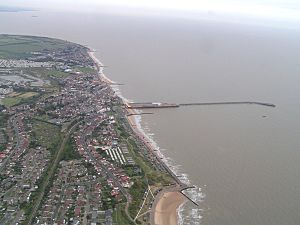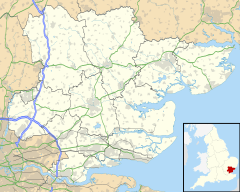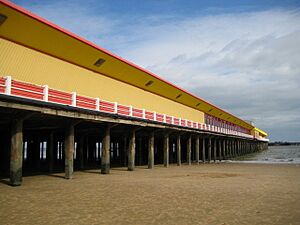Walton-on-the-Naze facts for kids
Quick facts for kids Walton-on-the-Naze |
|
|---|---|
 Walton-on-the-Naze |
|
| Population | 12,054 |
| OS grid reference | TM246214 |
| Civil parish | |
| District |
|
| Shire county | |
| Region | |
| Country | England |
| Sovereign state | United Kingdom |
| Post town | WALTON ON THE NAZE |
| Postcode district | CO14 |
| Dialling code | 01255 |
| Police | Essex |
| Fire | Essex |
| Ambulance | East of England |
| EU Parliament | East of England |
| UK Parliament |
|
Walton-on-the-Naze is a lovely seaside town located on the North Sea coast in Essex, England. It's part of the larger area called Frinton and Walton. The town is found north of Clacton and south of the port of Harwich. You'll find Frinton-on-Sea just south of Walton.
About 12,000 people live here, based on the 2011 census. Many visitors come to Walton-on-the-Naze each year. The main attractions are a special area called The Naze and the long pier.
Long ago, this area was known by different names, like Eadolfenaesse. The name Walton means a 'farm or village of the Britons'. The word 'Soken' refers to a special area that had its own rules.
Walton used to have a HM Coastguard team. This team helped organize sea rescues. Their main rescue center closed in 2015. Now, a national center handles these operations. Walton-on-the-Naze railway station connects the town by train. Along the coast, you can find many old fossils. Some of these fossils are up to 50 million years old!
Contents
Discover The Naze
The word "Naze" comes from an old English word meaning "headland" or "point of land". It's a special peninsula located just north of Walton-on-the-Naze.
Wildlife and Nature
The Naze is very important for birds that are flying long distances. It has a small nature reserve where you can see many different species. The marshy areas nearby, called Hamford Water, are also great for birds. You can spot wintering ducks and Brent geese there. Many bird watchers visit during the spring and autumn to see the migrating birds.
The Naze Tower
The Naze Tower is a tall, old building at the start of The Naze. It was built a long time ago to help ships find their way along the coast. Today, it's privately owned, but you can visit it. During World War II, the Naze Tower was used as a radar station. Radar helps detect planes and ships.
Coastal Erosion and Protection
Walton was once a farming village located further inland. But over many years, the sea has slowly worn away the land. This is called coastal erosion. The original medieval village of Walton is now under the sea! Its old church fell into the sea in 1798.
The Naze is still eroding quickly, losing about 2 meters of land each year. This erosion threatens the Naze Tower and the local wildlife. A group called the Naze Protection Society works to stop this erosion. Many schools visit The Naze to learn about erosion and how we can protect our coasts.
To protect the coast, people have built a sea wall and used large rocks called riprap. They also use structures called groynes to trap sand on the beach. Millions of tons of sand have been added to the beach to help protect it. Even with these efforts, the cliff near Naze Tower is still eroding fast. Some old pill boxes (small concrete bunkers) can be seen on the beach. They show how much land has been lost.
Ancient Fossils at The Naze
The cliffs at The Naze are a very important scientific site. They are made of two main layers of rock. The bottom layer is London Clay, which is about 54 million years old. On top of that is a sandy layer called Red Crag, which is about 2 million years old.
These layers contain many amazing fossils! You can find shells from ancient clams and snails, sharks' teeth, and even whale bones. The clay layer is famous for its pyritised fossils (wood that has turned into a mineral). It's also one of the best places to find rare bird bones. In 1998, the famous naturalist David Attenborough said that over 600 bird fossils had been found here!
Walton-on-the-Naze Climate
Walton-on-the-Naze has an oceanic climate, just like the rest of the British Isles. This means it has mild temperatures and rain throughout the year. Being on the North Sea coast, it gets a bit more influence from the sea than places further inland.
| Climate data for Walton-on-Naze (1991–2020) | |||||||||||||
|---|---|---|---|---|---|---|---|---|---|---|---|---|---|
| Month | Jan | Feb | Mar | Apr | May | Jun | Jul | Aug | Sep | Oct | Nov | Dec | Year |
| Mean daily maximum °C (°F) | 7.0 (44.6) |
7.9 (46.2) |
10.1 (50.2) |
12.1 (53.8) |
15.7 (60.3) |
18.8 (65.8) |
21.5 (70.7) |
21.0 (69.8) |
18.8 (65.8) |
15.0 (59.0) |
10.9 (51.6) |
7.9 (46.2) |
13.9 (57.0) |
| Mean daily minimum °C (°F) | 2.1 (35.8) |
2.6 (36.7) |
3.8 (38.8) |
6.0 (42.8) |
9.1 (48.4) |
12.0 (53.6) |
15.0 (59.0) |
14.6 (58.3) |
12.3 (54.1) |
9.5 (49.1) |
5.8 (42.4) |
2.9 (37.2) |
8.0 (46.4) |
| Average rainfall mm (inches) | 48.2 (1.90) |
45.9 (1.81) |
35.3 (1.39) |
33.3 (1.31) |
30.6 (1.20) |
36.9 (1.45) |
48.7 (1.92) |
58.5 (2.30) |
49.4 (1.94) |
54.6 (2.15) |
60.4 (2.38) |
53.9 (2.12) |
555.8 (21.88) |
| Mean monthly sunshine hours | 61.9 | 89.2 | 128.7 | 201.9 | 231.1 | 232.2 | 228.7 | 222.7 | 167.7 | 123.2 | 77.0 | 59.8 | 1,824 |
| Source: Met Office | |||||||||||||
Walton Pier History
The very first pier in Walton was built in 1830. It was one of the earliest piers in the whole country! It was used for boats to drop off goods and people. This first pier was made longer in 1848. Sadly, a big storm damaged it badly in 1871.
A second pier opened in 1880, but it also didn't last long. In 1895, a new company built a replacement pier. This one was 500 feet longer than the first! By 1898, it was extended even more to become the third longest pier in the country.
When the new pier opened, it even had an electric tramway. This tram took passengers from the boats to the front of the pier. It was later updated to a battery-powered carriage in 1935. After a fire damaged the pier in 1945, a diesel locomotive train replaced the carriage. This train was removed in the 1970s. In February 2021, part of the pier collapsed during Storm Darcy.
In 1937, Charles Goss bought the pier. He added an amusement arcade and a theater. The pier was sold again in 2016. In 2022, the pier got a big makeover with a large arcade area. It reopened to the public on July 16, 2022.
The Walton and Frinton lifeboat has been kept near the end of the pier since 1900. This lifeboat helps rescue people at sea.
Walton's War Memorial
Walton has a special war memorial. It remembers a Halifax aircraft crew who died when their plane crashed on The Naze. The memorial also honors Herbert George Columbine, a local hero who received the Victoria Cross medal. The local leisure center is named after him. There's also a tribute to those lost from HMS Conquest during World War I.
Old Lifeboat House
The old lifeboat house on East Terrace was built in 1884. It's a historic building and now holds the Walton Maritime Museum. It's a great place to learn about the town's sea history.
Famous People from Walton
- Frank Paton, an artist, moved to Walton-on-the-Naze shortly before he passed away in 1909.
- Ben Raemers, a professional skateboarder, grew up in Walton-on-the-Naze. He started skateboarding there when he was 10 years old.
How Walton is Governed
Even though Walton is now part of the "Frinton and Walton" parish, it still has its own local voting area. In 2011, about 4,372 people lived in this area. On April 1, 1934, Walton officially joined with Frinton to form "Frinton and Walton".
Images for kids
See also
 In Spanish: Walton-on-the-Naze para niños
In Spanish: Walton-on-the-Naze para niños




